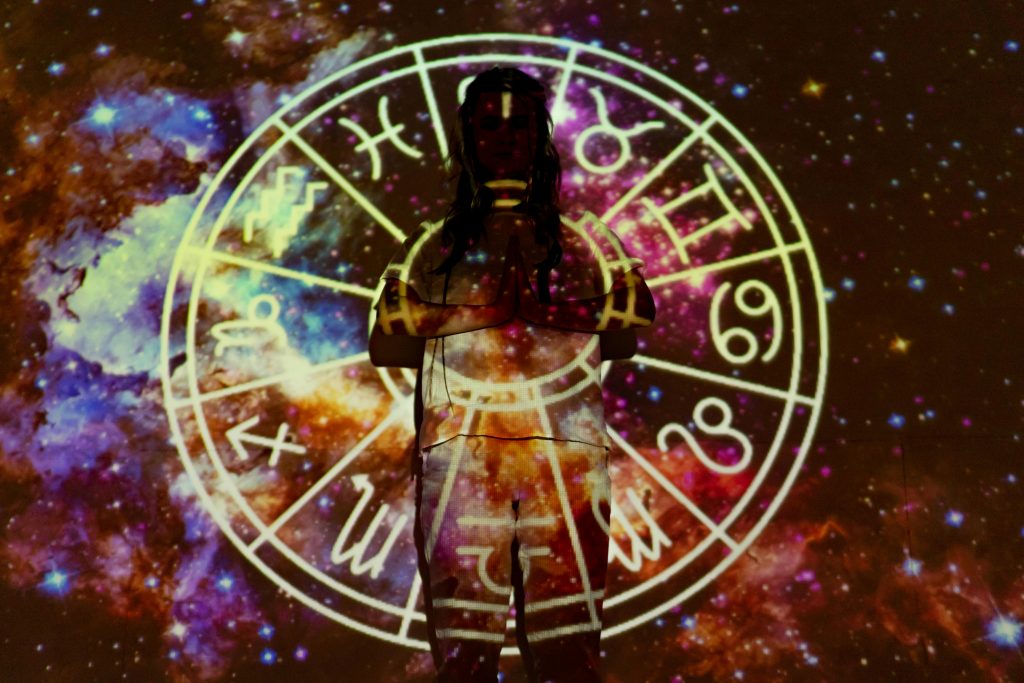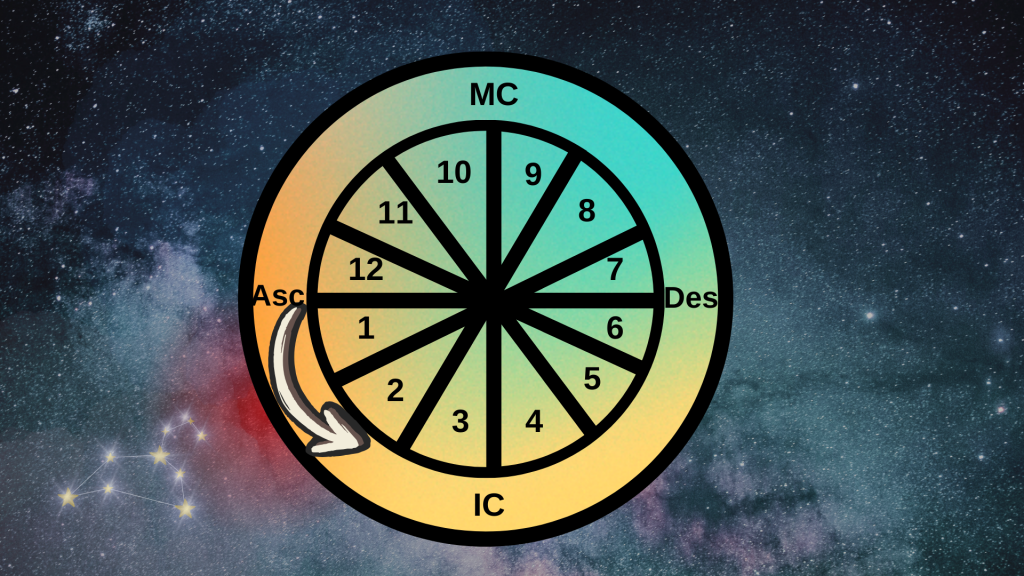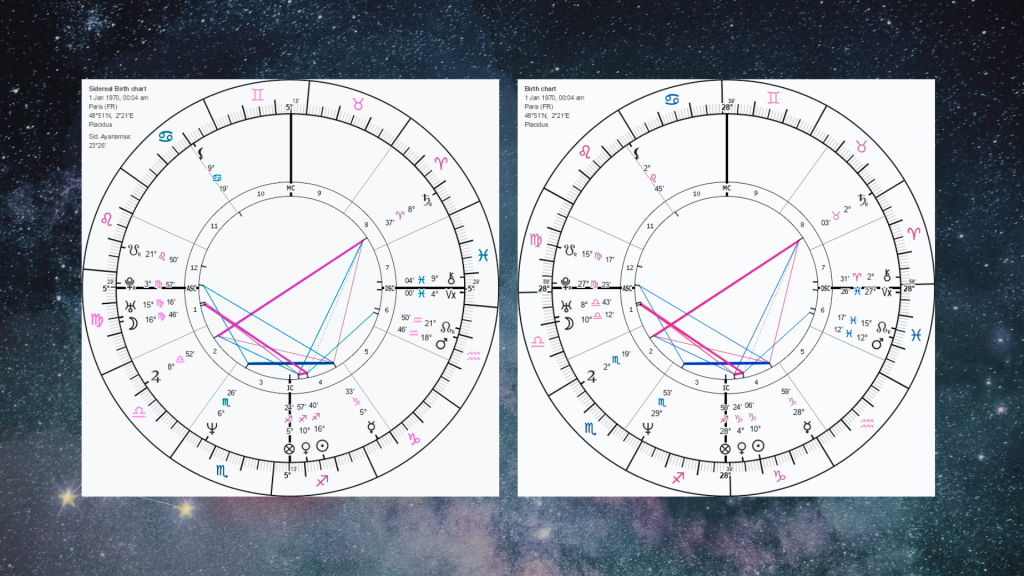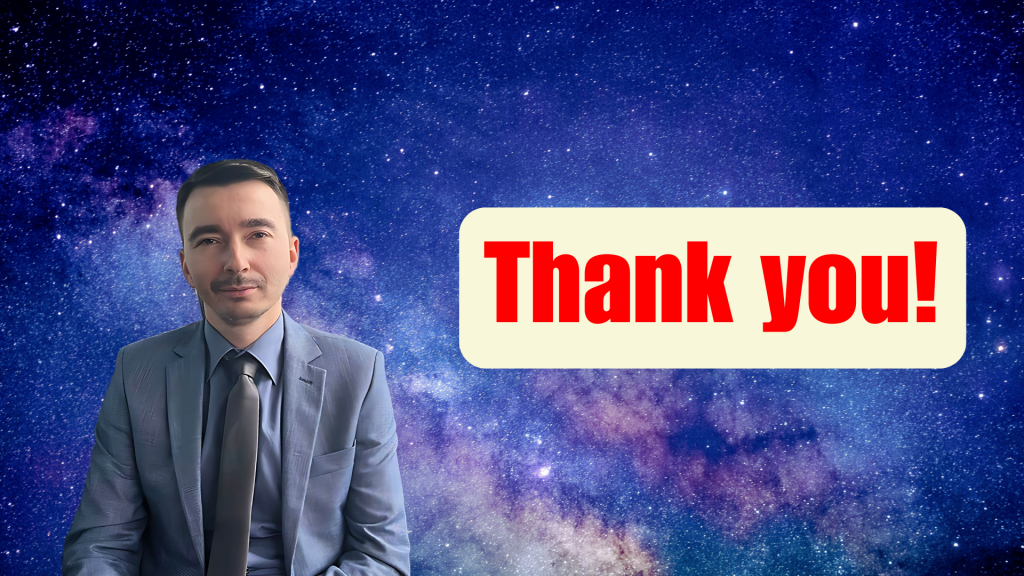What is astrology?
Astrology studies and interprets how celestial bodies movements impact human life.
According to the Romanian dictionary, astrology is:

the art of deciphering and predicting destinies based on studying the position and movement of stars, constellations or celestial phenomena.
How does astrology work?
Our astrology chart is a snapshot of how the Solar System and its planets were aligned when we were born. We inherit the celestial energy of that moment.
This celestial blueprint serves as a guide to understanding our personality, strengths, challenges, and life path.

Planets
In astrology, each planet represents something.
For example, Venus represents pleasures, public persona, and how our body processes sugar, and it represents the topics associated with the house occupied by the Taurus sign.
So, astrology is a multifaceted science—like an object in 4D dimensions.
On one side, it represents someone’s visible and psychological traits, the body’s metabolic characteristics, notoriety potential, and other invisible things.

Astrology chart structure
An astrological chart begins with the Ascendant point, where the first house moves counterclockwise. It represents planetary positions within a circular framework, like a snail biting its tail from the first house to the 12th house.
The ascendant-descendant line divides it into two parts (houses 1-6), while the Medium Coeli–Immum Coeli divides it into another two (houses 7-12)
An astrological chart has twelve houses, beginning with the Ascendant point, where the first house starts in a counterclockwise move. It represents planetary positions within a circular framework.

Astrological Houses
Each astrological house governs a specific aspect of life, such as identity, values, hobbies, health, and relationships. These correspond to the twelve consecutive signs assigned to the astrological houses.
Each house and its corresponding sign create a framework for planets to express their energy.
A person with Mercury in 1st house or Mercury in Gemini or Virgo will act more actively (public persona) than one with Mercury in the 12th house or Mercury in Pisces.

Depending on their sign, some planets manifest their true nature while others struggle.
For example, Mars in Libra tempers its fiery nature and gives people with it diplomatic qualities (left image)
Planets have specific angles between them, depending on their positions (if any)*. These criteria among the planets’ dignities can determine how some characteristics blend.
Astrology focuses mainly on the following angles: 0 degrees (conjunction), 60 degrees (sextile), 90 degrees (square), 120 degrees (trine), and 180 degrees (opposition)**.
Trine is considered the most beneficial aspect between planets, but it depends on whether the planets making this aspect (angle) are in good shape. It could be detrimental to them if they are not in their domicile or exaltation.
Note
*Not all the planets have angles between them (void planet).
** There are also major angles that astrologers don’t use too much, like 45 degrees (semi-square or octile), 135 degrees (sesquiquadrate or trioctile) or 150 degrees (quincunx or inconjunct) and minor angles.
Types of astrology systems
There are two astrological systems: a tropical and a sidereal system.
The tropical system (Western) uses the equinoxes and solstices to define the zodiac signs. The system is align with the seasons.
Sidereal system (Vedic) is based on the actual position of the stars and constellations, considering the precession of the equinoxes and the slight change in the position of the Earth’s axis over time.
A person with the Sun in Sagittarius in the tropical system will have the Sun in Capricorn in the sidereal system (image below).

The Brief History of Astrology
Astrology dates back over 4,000 years, but Claudius Ptolemy’s book – Tetrabiblos (2nd century AD) was the first written influential astrological text.
It originated in Mesopotamia, where the Sumerians first observed celestial patterns, and the Babylonians later formalized the zodiac.
These ideas spread to Egypt, Greece, and Rome, while a separate Vedic system developed in India.
The astrology wheel originated in Babylon when the ecliptic was first divided into 12 equal sections, laying the foundation for the modern zodiac system.

Dipu Sharma123 via Wikimedia)
Hellenistic astrologers expanded these concepts, integrating planetary aspects and houses, which later influenced medieval, Islamic and Renaissance astrology.
The Vedic system evolved separately in India, incorporating lunar mansions (Nakshatras) and karma-based interpretations. Scholars such as Varāhamihira and Parashara later refined it.
In the 20th century, Indian guru Bangalore Venkata Raman legitimized Vedic astrology and introduced it to universities in India.
Universities in the UK, the US, and Turkey have integrated astrology into their curricula.Kepler College at Washington State University and The Avalon School of Astrology in the United States offer astrology courses. Other universities worldwide also offer its courses.

Carl Gustav Jung, the founding father of analytical psychology, viewed astrology as a symbolic language.
The basic meaning of the horoscope is that, by mapping out the positions of the planets and their relations to one another (aspects), together with the distribution of the signs of the zodiac at the cardinal points, it gives a picture first of the psychic and then of the physical constitution of the individual. It represents, in essence, a system of original and fundamental qualities in a person’s character, and can therefore be regarded as an equivalent of the individual psyche.
Astrology in modern times
In the 20th century, astrology began to focus also on archetypal astrology.
One of the most prominent figures is Dane Rudhyar, the father of psychological astrology.
In the thirties, he introduced self-awareness and personal growth concepts, shifting astrology’s focus from fate to psychological development.
His work laid the foundation for further integration of astrology and psychology.
Later, in 1936, psychiatrist Carl Jung influenced astrology with his work on archetypes and the collective unconscious.
Jung’s psychological theories profoundly impacted astrologers like Richard Tarnas, who deepened their understanding of archetypal symbology and their connection to the individual and the collective human experience.
Before World War II, Reinhold Ebertin developed the midpoints concept, focusing on the relationships between planetary midpoints to derive meanings and predictions.
His book The Combination of Stellar Influences is a cornerstone book for astrologers interested in predictive techniques.
In the 1970s and beyond, astrologer Liz Greene integrated Jungian themes into astrology, contributing to the field’s psychological dimension with a focus on individual transformation.
2000’s
With the democratization of the Internet, astrology experienced a resurgence in popularity and accessibility.
Later on, after 2010, online platforms enabled astrologers to share their work, leading to the continued development of techniques such as electional astrology (choosing the most favorable times for events) and mundane astrology (predicting world events).

The astrologers Chris Brennan and Adam Elenbaas played significant roles in reviving techniques from the Hellenistic period, particularly those related to predictive methods and the timing of life events.
While Chris Brennan has focused primarily on restoring ancient Hellenistic astrology through detailed research and teaching, Adam Elenbaas has blended astrology with spiritual traditions, particularly mysticism, shamanism, and yogic practices.
His work emphasizes the importance of spiritual growth alongside traditional astrological techniques.
Post-2024 era
The rise of AI and the increased possibility of analyzing big data have further opened up new opportunities for astrology.
The modern software can now refine a chart analysis. It has also made it easier to identify patterns across historical events and correlate them with astrological transits.
As a result, astrology is becoming a more statistically and data-driven field, with enhanced symbol interpretation and analysis methods.
Applications
Health
Astrological charts can help us identify potential health vulnerabilities and illnesses.
Furthermore, by using electional astrology, you can choose a time that is beneficial for treatment or surgery.
For instance, in ancient times, medical doctors also had astrological knowledge. The two worked in symbiosis.
In ancient times, doctors used it to determine optimal treatment periods to speed healing and avoid complications.
However, this tradition has almost entirely been lost. Few astrologer practitioners use this timing technique on a massive scale in remote areas like Tibet.
In a personal case, the problematic electional chart with someone about to undergo a transfusion. We considered potential risks, which turned out to be a learning experience.
Astrology offers insights into interpersonal dynamics.
Astrological readings help decode personality traits, strengths, and areas for growth.
It can help individuals recognize behavioral patterns and navigate personal or psychological challenges.
In business, astrology can help provide a broader profile of a person; it can distinguish between a con and a serious partner. Thus, you can avoid people you don’t share the same values.
Navigation tool in career.
Understanding the meaning of planets in astrology can be tremendously helpful.
Astrology can provide you with specific areas to develop more harmonically. It doesn’t give a particular career path but can inform you about your chances of succeeding in a specific domain.
The relationships between planets and their function describe how the dynamics and big-picture framework will function in a career.
However, practicing it isn’t without its challenges.
Astrology straddles scientific observation and artistic interpretation, providing a distinctive lens through which to understand life.
Warning
Additionally, interpreting astrologic charts can generate intense feelings, which is unsuitable for faint-hearted people!

What is the Morraevo mission?
The modern world is experiencing a shift in values, upsetting many people.
As the world changes, some people seek deeper answers that traditional religious frameworks do not always provide.
So, this is not satisfactory on a personal level for less dogmatic individuals.
Therefore, in the last years, astrology has experienced a comeback, thanks to easy access to the Internet and a growing interest in spirituality.
Astrology is often misunderstood and mislabeled due to oversimplifications, overgeneralisations, and misrepresentations in mainstream media like television, newspapers, and the Internet.
Morraevo promotes deeper engagement with astrology, encouraging exploration beyond conventional beliefs.
By sharing real-life examples and insights into global events (historical and modern), we aim to deepen understanding and appreciation for this ancient practice.
Studying astrology reveals hidden truths about ourselves and gives us a richer perspective on the interconnectedness of all things.
A personal journey into the stars.
My journey began at age 12 when I read my first astrology book. Though it took almost two decades to return, curiosity eventually brought me back, and changed my life.
This search led me to study astrological charts relentlessly. Friends, coworkers, and even strangers revealed me more profound truths and an integrative view of the human experience as a whole.
Analyzing the astrological charts of celebrities provided insight into career development possibilities. But studying more everyday people, through their astrological interpretations, helped me correlate life events with astrological transits.
This spiritual practice deepened my understanding and self-awareness. People’s reactions are one of astrology’s most challenging yet enlightening aspects.
Is not just about the thrill and anticipation of self-discovery. This it is a tool for enlightenment and transformation. It is the abstract translation of the Universe!
Did you know that...?
US President Robert Reagan, through his wife Nancy, consulted an astrology reading just after his assassination attempt on March 30, 1981. Astrologer Joan Quigley helped the president navigate that period and schedule his public appearances using electional astrology. Therefore, his appearances were scheduled at odd times.

You too can use astrology to align with the cosmos and guide your life choices.
Discover Your Astrological Path! 📅 Book a Reading Today!
✨ Let the planets guide your steps!
✨ Gain clarity, align with the Universe, and confidently embrace the future!
📝 Disclaimer: Any fault accuracy in birth time may affect predictions many times.
Astrology articles
- The Astrology: Cancellation of the 2024 Romanian election
- Trump Already Won The Election? An Astrological Perspective
- Donald Trump: Another Assassination Attempt Looming? An Astrological Insight.
- Astrology of August 2024: Frustration, machination and plucking heads
- July 15, 2024: The future of the USA in great danger
- Israel-Iran in focus: When will Israel launch its massive attack?
- Total Solar Eclipse (8th April 2024) World War 3
- Full Astrological Chart Reading: When Will I Have Kids? Am I Suitable For This Job?
- How To Avoid Troubled Relatioships Using Astrology
- Pluto In Capricorn And Saturn In Pisces For The United States in 2023
- What The Future Of Israel Holds In October And November 2023
- Astrology Of Uranus-Pluto Conjunction In Virgo And Its Profound Implications
- Find Out How To Solve A Mystery Death From 2002
- The Second Phase Of Russian-Ukrainian War
- Astrology vs. Personal Development – Why People Want To “See” Their Future – Unlocking The Astrology Death Chart Of The Revolutionary Leader Lupșa Victor
- Mars Opposed Saturn | Mars Conjunct Chiron Manifested In My Life
- When Will The Ukraine War Will Start? The Astrology of Ukraine In 2022
References:
Dispelling Myths and Setting Realistic Expectations about Psychics.


